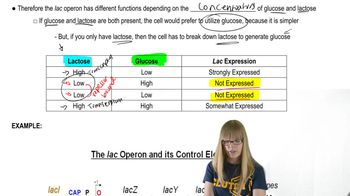Table of contents
- 1. Introduction to Genetics51m
- 2. Mendel's Laws of Inheritance3h 37m
- 3. Extensions to Mendelian Inheritance2h 41m
- 4. Genetic Mapping and Linkage2h 28m
- 5. Genetics of Bacteria and Viruses1h 21m
- 6. Chromosomal Variation1h 48m
- 7. DNA and Chromosome Structure56m
- 8. DNA Replication1h 10m
- 9. Mitosis and Meiosis1h 34m
- 10. Transcription1h 0m
- 11. Translation58m
- 12. Gene Regulation in Prokaryotes1h 19m
- 13. Gene Regulation in Eukaryotes44m
- 14. Genetic Control of Development44m
- 15. Genomes and Genomics1h 50m
- 16. Transposable Elements47m
- 17. Mutation, Repair, and Recombination1h 6m
- 18. Molecular Genetic Tools19m
- 19. Cancer Genetics29m
- 20. Quantitative Genetics1h 26m
- 21. Population Genetics50m
- 22. Evolutionary Genetics29m
10. Transcription
Transcription in Eukaryotes
Problem 2
Textbook Question
Write a short essay describing how cis-acting regulatory elements, activators, and chromatin modifiers are all coordinately involved in regulating transcription initiation.
 Verified step by step guidance
Verified step by step guidance1
Begin by explaining the role of cis-acting regulatory elements, which are DNA sequences located near the genes they regulate. These elements include promoters, enhancers, and silencers, and they serve as binding sites for transcription factors and other proteins that influence transcription.
Discuss how activators, which are proteins that bind to specific cis-acting elements, enhance the transcription of a gene. Activators can increase the rate of transcription by facilitating the assembly of the transcription machinery at the promoter or by recruiting coactivators.
Introduce chromatin modifiers, which are proteins that alter the structure of chromatin, making it more or less accessible to the transcription machinery. These modifiers can add or remove chemical groups to histones, leading to chromatin remodeling.
Explain the coordination between these elements: activators can recruit chromatin modifiers to specific sites on the DNA, leading to changes in chromatin structure that either promote or inhibit transcription. This coordination ensures that genes are expressed at the right time and in the right cells.
Conclude by highlighting the importance of this coordinated regulation in maintaining cellular function and responding to environmental signals. The interplay between cis-acting elements, activators, and chromatin modifiers is crucial for precise control of gene expression.
Recommended similar problem, with video answer:
 Verified Solution
Verified SolutionThis video solution was recommended by our tutors as helpful for the problem above
Video duration:
2mPlay a video:
Was this helpful?
Key Concepts
Here are the essential concepts you must grasp in order to answer the question correctly.
Cis-acting Regulatory Elements
Cis-acting regulatory elements are DNA sequences located near a gene that influence its transcription. These elements, such as promoters and enhancers, serve as binding sites for transcription factors and other proteins that regulate gene expression. Their proximity to the gene allows them to directly affect the recruitment of the transcription machinery, thereby playing a crucial role in the initiation of transcription.
Recommended video:
Guided course

Human Transposable Elements
Activators
Activators are proteins that bind to specific cis-acting regulatory elements to enhance the transcription of a gene. They facilitate the assembly of the transcriptional machinery at the promoter by recruiting additional factors and modifying the chromatin structure. By increasing the likelihood of RNA polymerase binding to the promoter, activators are essential for initiating transcription and ensuring that genes are expressed at the right time and level.
Recommended video:
Guided course

Lac Operon Summary
Chromatin Modifiers
Chromatin modifiers are proteins that alter the structure of chromatin, the complex of DNA and proteins that make up chromosomes. These modifiers can add or remove chemical groups from histones, leading to changes in chromatin accessibility. By making the DNA more or less accessible to the transcription machinery, chromatin modifiers play a critical role in regulating transcription initiation, often working in concert with activators and cis-acting elements to fine-tune gene expression.
Recommended video:
Guided course

Chromatin

 9:16m
9:16mWatch next
Master Eukaryotic Transcription with a bite sized video explanation from Kylia Goodner
Start learningRelated Videos
Related Practice


